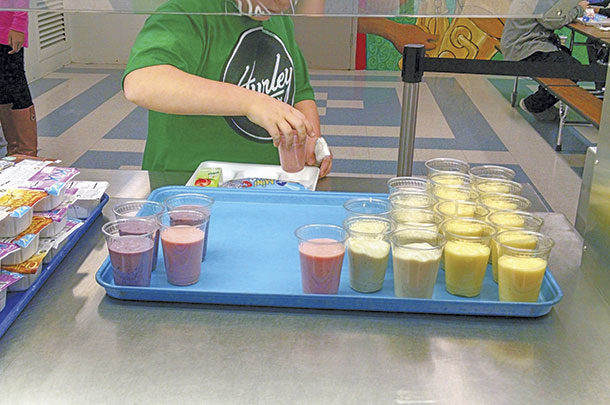When it comes to mealtime, every parent knows it doesn’t matter how healthy the food you serve is; if the kids won’t eat it, it’s not nutritious. As parents, we try to encourage our kids to make healthier choices when eating and snacking at home, but what about at school?
Midwest Dairy has been working closely with schools for generations to provide healthy and nutritious options for students, but the same holds true: Those choices only work when kids actually choose to consume them.
At school, food choices are critical for fueling students’ energy, resiliency and ability to concentrate and be successful in the classroom. Dairy is a critical piece of that puzzle. As the world changes, and as schools continue to adapt to what today’s students want and need, the ways in which dairy is incorporated into school meals must change as well. While serving milk with meals is still an essential element of school nutrition programs, kids also want and seek out foods that are fun, customizable and easy to consume on the go as they rush to their next class or off to practice. But most importantly, they want choices that are appealing and taste good.
Dairy fits the bill for all of these things, which is why Midwest Dairy is successfully partnering with schools across our 10-state region to create innovative in-school meal programs that incorporate a variety of on-trend options kids really want. By focusing on how food trends impact what kids will choose for meals and snacks, we’ve been able to create new programs that are not only moving the needle when it comes to more dairy consumption throughout the day, but also building lifelong dairy consumers along the way. Here are a few examples:
- Smoothie programs are a huge hit. No matter what age or grade, smoothies are an extremely popular option for both kids and adults. They’re on the menu at coffee shops and restaurants, and even grocery and convenience stores have installed smoothie bars. According to recent Nielsen data, smoothies accounted for $22.6 million in grocery store sales alone last year, up 84% from the previous year. When kids can also have smoothies at school, it helps emulate fun, “real world” experiences they enjoy.
Not only are these smoothie programs providing kids with the essential nutrients they need to perform their best throughout the day, thanks to their health profile, dairy-based smoothies are now considered a reimbursable school meal when paired with another food such as a whole grain, making them an even smarter option for school districts. Smoothie programs are also a wise choice for schools as they are convenient and can be offered in a variety of formats throughout the day. Whether it’s for second-chance breakfast, served from stand-alone carts or at a grab-and-go snack station, smoothies are the perfect choice no matter the time of day.
The smoothie trend is having a real impact on current dairy sales while building future dairy demand, a win-win for both kids and the industry. One recent example: Wichita Public Schools implemented second-chance breakfast and smoothies at 13 middle and high schools last year, resulting in more than 216,500 incremental pounds of milk sold. Like many others, the district alternated in and out of distance learning due to the pandemic, showcasing the enormous potential for this program in future years when students will be back in school full time. This school year, there are several new smoothie programs in the works in Illinois, Minnesota, Missouri, South Dakota, Iowa and Nebraska – all of which have the potential to reach thousands of students and make a significant impact on the amount of milk sold across the region.
- Dairy fits the bill for health and nutrition. Dairy offers so many key nutritional benefits families and schools rely on to support healthy learning and development. Not only does dairy taste good, but its 13 essential nutrients are crucial for building a healthy immune system. Teachers, principals, counselors and school health professionals are recognizing the additional health and wellness benefits of dairy, such as its digestive benefits, the energy boost it provides and that it’s produced in a sustainable way – all things that align with the values kids want from their foods as well.
- When the weather cools down, warm beverage options heat up. As fall turns to winter, it’s no surprise kids want more “seasonal” options during the day. Heating chocolate milk to serve as hot chocolate is a great way to increase milk consumption, making a tried-and-true beverage a fun, trendy, delicious treat. What’s great about this option for schools is: It is also part of a reimbursable meal as the students’ milk choice, creating a win-win for both the students and the school. Midwest Dairy has created a toolkit that can be found on its website which provides additional resources for schools to help implement hot chocolate milk programs and get more dairy into students’ hands. By paying attention to kids’ shifting needs and preferences throughout the year, Midwest Dairy is creating programs that not only increase dairy consumption now but will also continue to have an impact on driving demand as these kids make beverage choices outside of school.
As kids head back to school and our current world and learning environments continue to adapt, Midwest Dairy continues to stay ahead of what kids and their parents are looking for when it comes to dairy choices. We are continually looking to partner with school nutrition professionals to find new and innovative ways to give students a fun and positive dairy experience that provides the important nutrition they need while continuing to drive dairy demand now and into the future. And while the trends evolve over the years, one thing will remain constant: Dairy will continue to play a leading role in helping schools provide the healthy, nutritious and fun food options kids of all ages will continue to love for generations to come.







